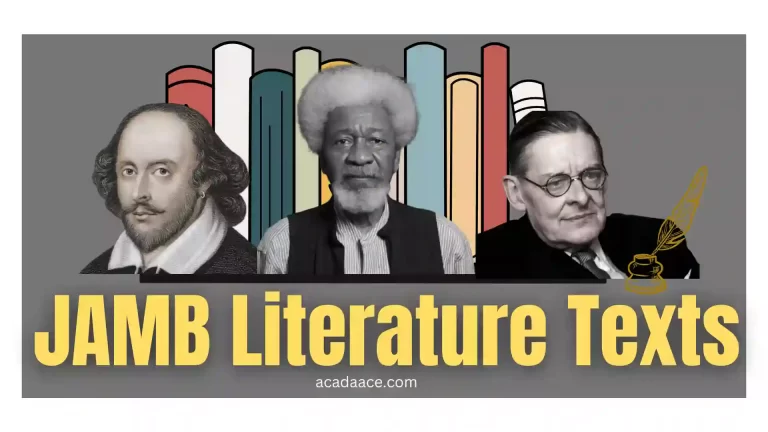All elements of drama alphabetically
Drama is an important aspect of Literature in English and all elements of drama alphabetically, must be properly understood by any student writing the examination in the subject. In this article, I will explain tin details all elements of drama alphabetically. You can see some recommended JAMB Literature in English books here. Without wasting of time, let’s get to work!
- What are elements of drama?
- Some common elements of drama
- Action
- Audience
- Character
- Climax
- Conflict
- Contrast
- Convention
- Dialogue
- Dramatic moment
- Energy
- Focus
- Language
- Metaphor in drama
- Mood
- Movement in drama
- Music in drama
- Plot
- Posture
- Rhythm in drama
- Setting
- Situation in drama
- Space in drama
- Spectacle (all elements of drama)
- Structure
- Symbol among all elements of drama
- Tension in drama
- Theme
- Time
- Timing
- Voice
What are elements of drama?
The elements of drama are the fundamental components that make up a play or stage performance. These elements work together to create a cohesive and engaging story and to explore the themes and ideas of the play. They include:
Some common elements of drama
Over the years, there have been conflict as per what should be included in elements of drama. But as time goes on, it was discovered that all elements of drama are dynamic and can take a different form in different scenario.
- Plot: This refers to the sequence of events that make up the story, including the rising action, climax, and resolution.
- Character: This refers to the people or beings who populate the world of the play, including the protagonist and antagonist, as well as the supporting characters.
- Theme: This refers to the underlying message or main idea that the play is exploring. It is the central idea or insight that the playwright is trying to convey through the events and characters of the story.
- Dialogue: This refers to the words spoken by the characters in the play. It can be used to reveal character, advance the plot, and explore themes.
- Setting: This refers to the time and place in which the play is set, including the physical location, historical period, and social context.
- Music: This refers to the use of music in the play, including songs, instrumental pieces, and sound effects.
- Spectacle: This refers to the visual and physical elements of the play, including sets, costumes, and special effects.
Action
Action in drama refers to the progression of the plot from one moment to the next. It is an important element that helps to shape the structure of the play, moving the story forward through the exposition, inciting incident, rising action, crisis, climax, falling action, and conclusion. The structure of a play refers to the way in which it is organized and arranged, and it can have a significant impact on the overall narrative and themes of the drama.
Audience
An audience can specifically refer to the engagement actors have with their audience through performance, known as the actor-audience relationship.
The exact nature of this relationship can vary depending on the style of the performance.
Character
In drama, a character is a fictional person or being who appears in the play or story. Characters are the people or creatures who populate the world of the drama and drive the action of the plot. They have their own personalities, motivations, goals, and desires, and they interact with one another and the events of the story in various ways. The characters of a play can be major or minor, and they can be complex or simple. They may be round characters, with fully developed personalities and multiple dimensions, or they may be flat characters, with fewer characteristics and less depth. The characters of a play are an important element of the drama, and they help to create the story and bring it to life for the audience.
Climax
In most dramas, there will be one or more crises that occur as the plot develops. These crises are significant moments of tension and conflict, usually involving two or more characters and having significant consequences for the outcome of the story. The crisis that is considered the most important and has the most impact on the plot is known as the climax, which typically (but not always) occurs near the end of the play. It is possible for a drama to have more than one climax, although this is not common. An anti-climax, which is the opposite of a climax, is also possible.
Conflict
Conflict is an essential element of drama, as it helps to create tension and interest in the story. Without conflict, a drama is likely to be dull and unengaging. Conflict can occur between two or more characters, or it can be internal, involving a character’s own thoughts and feelings. It can be verbal, physical, or non-verbal. Conflict is a fixed and permanent part of the structure of a play, often present from the beginning and shaping the actions and relationships of the characters. Tension, on the other hand, is a temporary feeling of unease or suspense that may be created through the use of conflict or other dramatic elements.
Contrast
Contrast is an important element of drama that helps to create interest and tension in a performance. It is achieved through the use of differences, such as a change in setting, pace, or time, or through the contrast of characters. This can be achieved through changes in language, timing, mood, lighting, energy, relationships, situation, and other elements. By carefully using contrast, a drama can keep an audience engaged and invested in the story.
Convention
Conventions are specific techniques used in drama to enhance the performance or storytelling. These may include the use of a narrator, an aside, a soliloquy, a direct address, placards, songs, and other elements. Conventions are often associated with particular performance styles or theatre practitioners, and they may also be linked to specific eras or styles of theatre, such as absurdism or Elizabethan theatre.
Dialogue
Dialogue is the conversation and speech of the characters in a play or stage performance. It is an important element of drama, as it can be used to reveal character, advance the plot, and explore themes.
Super tips for writing good dialogue
Some tips for writing effective dialogue in drama include:
- Make the dialogue authentic and believable: The characters’ dialogue should sound natural and authentic, and it should reflect their personality, background, and circumstances.
- Use subtext: Subtext refers to the underlying meaning or emotion that is conveyed through the words and actions of the characters. Adding subtext to the dialogue can help to make it more nuanced and interesting.
- Vary the pace and rhythm of the dialogue: The pace and rhythm of the dialogue can be used to create tension, build suspense, or convey emotion.
- Use silences and pauses effectively: Silences and pauses can be an effective way to create tension and suspense or to allow the audience time to reflect on the events and emotions of the story.
- Avoid expository dialogue: Expository dialogue is dialogue that is used solely to convey information to the audience, rather than advancing the plot or revealing character. Avoiding expository dialogue can help to make the dialogue more natural and engaging.
Dramatic moment
A dramatic moment is a specific, often brief, period of time in a play that is characterized by high tension or drama. This may involve loud noises and movement, but it can also be a poignant moment of stillness or silence. Dramatic moments can involve one or more actors and may or may not require sets and props. They often change the tempo and rhythm of the play and are often used to manipulate tension and create contrast.
Energy
Energy refers to the intensity or vitality of a character’s actions in a drama. This can vary from high energy to low energy, and it can involve both lively and energetic characters as well as slow, tired, or disheartened characters. To effectively portray a character with a certain type of energy, the performer must embody that energy themselves. Energy can also refer to the intensity of a performance or the overall style of a show, such as a musical.
Focus
In drama and performance, focus refers to the emphasis placed on a specific element or area. In theatre, this can be achieved through various techniques, such as directing the attention of the audience, using lighting, and other methods. Focus is used to highlight a particular area or character and give it emphasis. It is a key element of drama and performance that helps to guide the audience’s attention and create a sense of importance or significance.
Language
Language in drama and performance can be verbal, vocal, or non-verbal. Verbal language is spoken text, typically from the written script of the play. Vocal language may be spoken or sung, and it can also be used in a nonsensical way for dramatic effect. The choice of language is an important element of drama, as it is a key means of communicating the story to the audience. The actor’s use of language is often influenced by their skill in using their voice, but it can also involve non-verbal communication, or body language. The use of the voice is the process of speaking the verbal language, while language itself refers to the words being spoken.
Metaphor in drama
A dramatic metaphor is a literary device that uses a comparison or analogy to convey meaning or significance in a play or other work of drama. It is a way of expressing ideas or themes indirectly, through the use of figurative language. For example, a character in a play might compare their situation to being trapped in a cage, using the cage as a metaphor for the limitations or constraints they are facing. Dramatic metaphors can be used to add depth and complexity to a character or situation, and they can help to convey the underlying themes or messages of the drama.
Mood
In drama, mood refers to the atmosphere or emotional tone of the play. It is the feeling or emotion that is evoked in the audience as they watch the performance. Mood can be created through the use of various elements, such as the setting, music, lighting, dialogue, and the actions and experiences of the characters. For example, a play set in a dark and gloomy forest might create a mood of fear or unease, while a play set in a bright and sunny garden might create a mood of joy or happiness. The mood of a play can have a significant impact on the way in which the story is received and interpreted by the audience.
Movement in drama
Movement in drama refers to the physical actions and movements of the characters on stage. This can include their gestures, posture, and overall physical presence. Movement can be used to convey meaning and emotion, and it can also help to advance the plot and enhance the overall performance. Movement can be used in a variety of ways, such as to indicate a character’s state of mind, to emphasize a particular line of dialogue, or to set the stage for a specific action or event. The use of movement can be an important element of drama, helping to bring the characters and story to life for the audience.
Music in drama
Music can play a variety of roles in drama, depending on the specific production and the intentions of the creators. Some common ways in which music is used in drama include:
- Setting the tone: Music can help to establish the mood and atmosphere of a scene, setting the tone for the action that follows.
- Creating tension: Music can be used to build tension and suspense, helping to create a sense of anticipation or unease.
- Enhancing emotion: Music can help to amplify the emotional impact of a scene, adding depth and resonance to the characters’ feelings and experiences.
- Supporting the action: Music can be used to support and underscore the action on stage, helping to convey the meaning and significance of the events depicted.
- Providing transitions: Music can be used to smooth transitions between scenes or acts, helping to smooth out the overall flow of the drama.
Overall, the use of music in drama can help to enrich the storytelling and add depth and complexity to the characters and events depicted on stage.
Plot
In drama, the plot is the series of events that make up the story of a play. It includes the setting, characters, and conflict, as well as the rising action, climax, and resolution. The plot is the framework that holds the play together and gives it meaning and purpose. It is what drives the story forward and keeps the audience engaged and invested in the characters and their actions. The plot of a play may be simple or complex, and it may involve various subplots or themes. The way in which the plot is structured and unfolds can have a significant impact on the overall tone and meaning of the drama.
Posture
In drama, posture refers to the position or carriage of the body. It includes the way in which a character stands, sits, or moves, and it can convey meaning and emotion through physical action. For example, a character who is standing tall and confident might convey a sense of strength and determination, while a character who is hunched over and hesitant might convey a sense of insecurity or fear. Posture can be an important element of drama, helping to enhance the performance and convey the feelings and intentions of the characters. It can also help to set the stage for specific actions or events, and it can help to create a sense of atmosphere or mood.
Rhythm in drama
In drama, rhythm refers to the flow and timing of the performance. It includes the pace at which the action unfolds, as well as the rhythms of dialogue, music, and movement. Rhythm can help to create a sense of momentum and keep the audience engaged in the story. It can also be used to convey meaning and emotion, and it can be used to create contrast and tension. For example, a slow, deliberate rhythm might convey a sense of tension or suspense, while a fast, energetic rhythm might convey a sense of excitement or urgency. Rhythm is an important element of drama, and it can have a significant impact on the overall tone and feel of the performance.
Setting
In drama, the setting is the place and time in which the action of the play occurs. It can be a specific location, such as a house or a park, or it can be a more general setting, such as a city or a countryside. The setting can also include the time period in which the play takes place, such as the present day or a specific historical era. The setting of a play can have a significant impact on the story and the characters, and it can help to establish the mood and atmosphere of the drama. The setting can be an important element of the play, and it can help to create a sense of realism and immersion for the audience.
Situation in drama
In drama, the situation refers to the set of circumstances or events that serve as the backdrop or context for the action of the play. It includes the time, place, and specific events that have led up to the events depicted in the play. The situation helps to establish the setting and provide context for the characters and their actions, and it plays a significant role in shaping the overall plot and themes of the drama. It is often established through the use of exposition, dialogue, and action at the beginning of the play and is developed and revealed throughout the course of the story.
Space in drama
In drama, space refers to the physical area in which the action of a play or performance takes place. This can include the stage and any areas in the audience’s view, as well as any offstage or backstage areas that are used during the performance. The use of space in drama can be an important element of the production, as it can help to create a sense of place and atmosphere, and can also be used to convey meaning and symbolism.
There are many different ways that space can be used in drama, including the use of stage design, lighting, and blocking (the movement and positioning of actors on stage). The choice of space can also influence the way that a story is told, as different spaces can convey different moods or emotions. For example, a cramped, cluttered space may create a sense of tension or claustrophobia, while an open, expansive space may create a sense of freedom or openness.
The use of space in drama can also be influenced by the style of the play or performance. For example, a traditional, realist play may use a more realistic, detailed set to create a sense of believability, while a more experimental or abstract performance may use a minimal or abstract set to create a more symbolic or metaphorical space.
Spectacle (all elements of drama)
In drama, the term “spectacle” refers to elements of a performance that are designed to be visually impressive or striking. These can include special effects, elaborate costumes and sets, or any other visual elements that contribute to the overall impact of the performance.
The use of spectacle in drama can serve a variety of purposes. It can be used to create a sense of wonder or awe in the audience, or to make a performance more memorable or memorable. It can also be used to convey meaning or symbolism, or to help transport the audience to a different time or place.
However, it’s important to note that the use of spectacle in drama should be balanced with other elements of the performance, such as character development, plot, and dialogue. If the spectacle becomes too dominant, it can distract from the overall story or message of the performance.
Structure
The structure of a drama refers to the way in which the story is organized and presented. There are many different structures that can be used in drama, and the specific structure chosen will depend on the particular needs and goals of the production. Some common structures that are used in drama include:
- Linear structure: This is a straightforward, chronological structure in which the events of the story are presented in the order in which they occurred.
- Non-linear structure: This structure involves presenting the events of the story out of chronological order, often using flashbacks or other techniques to jump back and forth in time.
- Multiple storylines: This structure involves interweaving multiple storylines or plot threads, allowing the audience to see how they intersect and relate to one another.
- Episodic structure: This structure involves dividing the story into distinct episodes or chapters, with each episode focusing on a specific event or set of events.
- Frame story: This structure involves using a frame story, or a story within a story, in which the main action is framed by a larger narrative context.
Above all, among all elements of drama the structure of a drama is an important aspect of the storytelling and can have a significant impact on the way the audience experiences and understands the events of the story.
Symbol among all elements of drama
A symbol in drama is a object, character, or action that represents something beyond itself and stands for something else. Symbols can be used to represent a wide range of concepts and ideas, including emotions, values, beliefs, and abstract concepts. In drama, symbols can be used to add depth and complexity to the characters and events depicted on stage and to explore themes and ideas in a more subtle and nuanced way.
Some common symbols that are used in drama include:
- Objects: Objects such as a wedding ring, a crystal, or a piece of jewelry can be used to symbolize love, purity, or wealth.
- Characters: Characters can be used to symbolize different aspects of human nature or represent specific ideas or values.
- Actions: Actions such as tearing down a wall or crossing a threshold can be used to symbolize overcoming obstacles or making a significant change.
worth knowing is that the use of symbols in drama can help to enrich the storytelling and add layers of meaning and interpretation to the events and characters depicted on stage.
Tension in drama
In drama, tension refers to the sense of conflict, suspense, or unease that is created in the audience through the events and actions of the story. Among all elements of drama, tension is an important element of and it can be used to engage the audience and keep them invested in the story. Tension can be created in a variety of ways, including through the use of dialogue, character conflict, plot twists, and suspenseful music.
Types of tension
There are several different types of tension that can be used in drama, including:
- Internal tension: This refers to the internal conflict or struggle experienced by a character, often as a result of their desires, motivations, or beliefs.
- External tension: This refers to the conflict or struggle between characters or between a character and their environment, often as a result of opposing goals or desires.
- Structural tension: This refers to the overall tension created by the structure of the story, such as the use of non-linear storytelling or multiple storylines.
- Emotional tension: This refers to the tension created by the emotional experiences and reactions of the characters, such as fear, anger, or love.
Theme
The theme of a drama is the underlying message or main idea that the play is exploring. It is the central idea or insight that the playwright is trying to convey through the events and characters of the story. The theme of a drama can be revealed through the actions and dialogue of the characters, the events of the story, and the overall setting and context of the play.
Some common themes that are explored in drama include:
- Love: This theme includes the various forms of love, such as romantic love, familial love, and self-love, and how they shape and influence the characters and events of the story.
- Loss: This theme explores the impact of loss and grief, including the ways in which people cope with and move on from loss.
- Power: This theme looks at the ways in which power is exercised, contested, and abused, and how it shapes the relationships and actions of the characters.
- Identity: This theme examines the ways in which people’s identities are shaped and how they navigate the complexities of self-discovery and self-acceptance.
- Social issues: This theme explores issues that are relevant to society, such as race, gender, class, and politics, and how they affect the lives and experiences of the characters.
Time
Time is a crucial aspect of drama that helps set the stage for the story’s events. It can be set in the present, past, or future and can be presented chronologically, non-chronologically, in a condensed form, or in real time. The way in which time is presented can influence the audience’s understanding of the story and its characters.
Timing
Timing in drama refers to the way in which the events and actions of the story are paced and presented to the audience. Good timing is essential in drama, as it helps to keep the audience engaged and interested in the story, and it can have a significant impact on the overall effectiveness and impact of the play.
Factors affecting timing in drama
There are several factors that can affect timing in drama, including:
- The length of the scenes: The length of the scenes in a play can have a big impact on the pacing and timing of the story. Shorter scenes can create a sense of energy and momentum, while longer scenes can give the audience time to absorb the events and emotions of the story.
- The use of pause and silence: The use of pause and silence can be an effective way to create tension and suspense, or to allow the audience time to reflect on the events of the story.
- The use of music: Music can be used to help set the tone and pace of a scene, and to help build tension or create a sense of suspense.
- The use of dialogue: The pace and timing of the dialogue can also have an impact on the overall timing of the story. Fast-paced dialogue can create a sense of energy and excitement, while slower-paced dialogue can give the audience time to absorb the events and emotions of the story.
Voice
In drama, the term “voice” can refer to a few different things:
- The voice of a character: This refers to the unique way in which a character speaks, including their tone, inflection, and mannerisms. A character’s voice can be used to reveal their personality, emotions, and thoughts.
- The voice of the playwright: This refers to the unique perspective and style of the playwright, which is revealed through the words and actions of the characters and the overall structure and themes of the play.
- The voice of the actor: This refers to the way in which an actor uses their voice and vocal skills to bring a character to life and convey their emotions and thoughts.
Overall, the use of voice in drama is an important tool for creating rich, nuanced, and believable characters and for exploring the themes and ideas of the play.
Conclusively, this list looks inexhaustible but all elements of drama have been touched one after the other. If you have any contribution to make, kindly write your contribution in the comment box below. I will do well to attend to it on time.










3 Comments